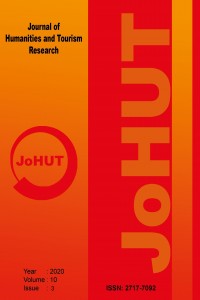Öz
Kaynakça
- Akinci, S. (2016). A cross-disciplinary study of stance markers in research articles written by students and experts, Unpublished PhD Thesis Submitted to Iowa State University.
- Dahl, T. (2004). Textual metadiscourse in research articles: a marker of national culture or of academic discipline? Journal of Pragmatics,36, 1807– 1825.
- Dressen-Hammouda, D. (2014). Measuring the voice of disciplinarity in scientific writing: A longitudinal exploration of experienced writers in geology. English for Specific Purposes, 34, 14-25.
- Dunleavy, P. (2003). Authoring a PhD: how to plan, draft, write and finish a doctoral thesis or dissertation. Hampshire, UK: Palgrave Macmillan.
- Eggins, S. (1994). An Introduction to systemic functional linguistic. London: Pinter.
Öz
The authorial voice is a significant aspect in the academic genres. Therefore, the issue of metadiscourse markers has been analysed by several studies. Hence, this study explores the use of metadiscourse in the abstracts of 100 journal articles published in ten Scopus indexed journals listed as the top free access journals based on the Scientific Journal Ranking (SJR) website. Five journals belong to the hard domain, whereas the other five journals belong to the soft domain. The Systemic Functional Linguistics approach (SFL) was adopted to analyse the frequency and wordings of modality within the 100 abstracts. Data were analysed manually qualitatively and quantitatively in order to highlight the possible similarities and differences between the abstracts of the hard domain and the soft one. The findings showed that the writers of both sets of abstracts employed finite modal operators, verbs, mood adjuncts, and comment adjuncts in expressing modality. These metadiscourse markers expressed different types, value, and orientation regarding modalization and modulation. Consequently, these findings could be employed pedagogically to equip novice writers with the linguistic skills that basically contribute to their academic success in writing academic genres.
Anahtar Kelimeler
Academic writing Metadiscourse Markers Modality, Systemic Functional Linguistics
Kaynakça
- Akinci, S. (2016). A cross-disciplinary study of stance markers in research articles written by students and experts, Unpublished PhD Thesis Submitted to Iowa State University.
- Dahl, T. (2004). Textual metadiscourse in research articles: a marker of national culture or of academic discipline? Journal of Pragmatics,36, 1807– 1825.
- Dressen-Hammouda, D. (2014). Measuring the voice of disciplinarity in scientific writing: A longitudinal exploration of experienced writers in geology. English for Specific Purposes, 34, 14-25.
- Dunleavy, P. (2003). Authoring a PhD: how to plan, draft, write and finish a doctoral thesis or dissertation. Hampshire, UK: Palgrave Macmillan.
- Eggins, S. (1994). An Introduction to systemic functional linguistic. London: Pinter.
Ayrıntılar
| Birincil Dil | İngilizce |
|---|---|
| Bölüm | MAKALELER |
| Yazarlar | |
| Yayımlanma Tarihi | 30 Eylül 2020 |
| Yayımlandığı Sayı | Yıl 2020 Cilt: 10 Sayı: 3 |

